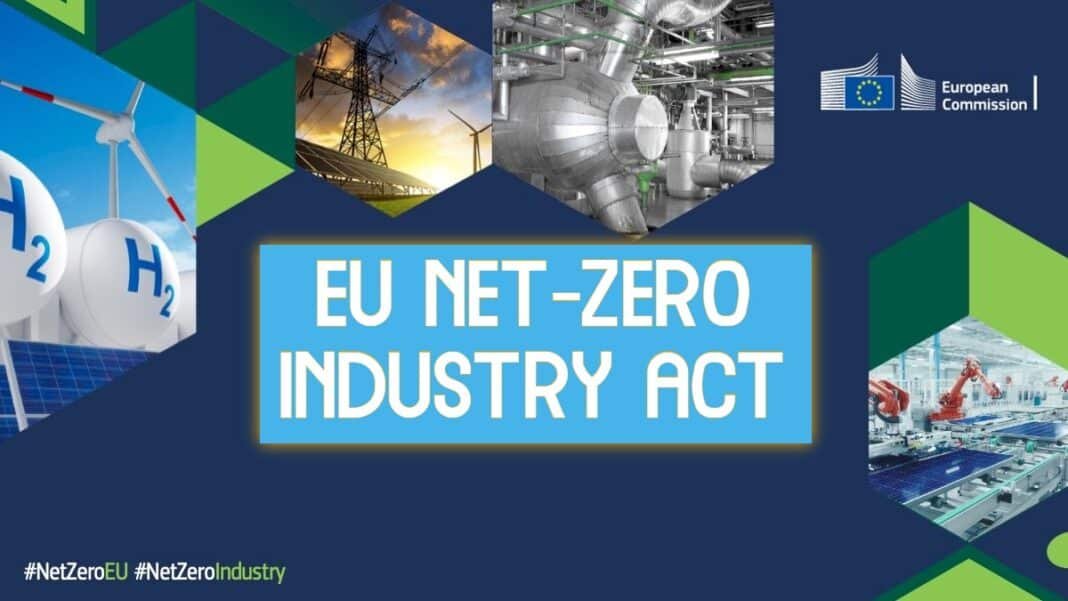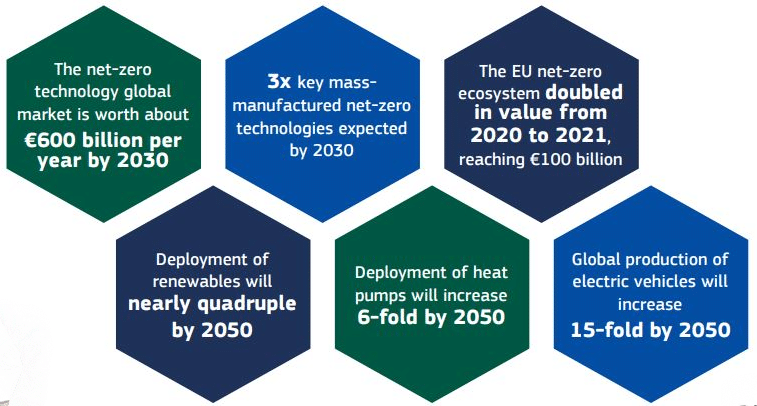The European Commission (EC) proposed the Net-Zero Industry Act to ramp up manufacturing of clean technologies in the EU and make the bloc prepared for the clean energy transition.
The Act is part of the $270 billion Green Deal Industrial Plan announced by EC President Ursula von der Leyen in Davos last month. The Plan will support Europe’s race to green transition and boost its net zero industry.
The EU net zero ecosystem doubled in value from 2020 to 2021, hitting 100 billion Euros. But currently, the region still largely relies on imports for most of its net zero technologies as follows:
- Over 90% of solar photovoltaic (PV) wafers and other PV components are from China
- More than ¼ of electric cars and batteries are also from China
In fact, China accounts for 90% of global investments in net zero technology manufacturing facilities and the proposed Act will try to change that.
What is the Net-Zero Industry Act?
The Net-Zero Industry Act will create a simpler and more predictable legal framework for net zero industries in the EU. It will make the region’s energy system more sustainable and secure while creating better conditions for net zero projects.
- The goal of the Act is to make Europe’s overall strategic net zero tech manufacturing capacity reach at least 40% of the bloc’s deployment needs by 2030.
Achieving this aim will help the EU speed up progress toward its energy and climate targets and move towards climate neutrality. Moreover, the Act will boost the region’s industry competitiveness, create green jobs, and support Europe’s efforts to be energy independent.
As per the EC President:
“We need a regulatory environment that allows us to scale up the clean energy transition quickly. The Net-Zero Industry Act will do just that. It will create the best conditions for those sectors that are crucial for us to reach net-zero by 2050… Demand is growing in Europe and globally, and we are acting now to make sure we can meet more of this demand with European supply.”
With that, the Net-Zero Industry Act sets out a clear framework to reduce the EU’s reliance on highly concentrated imports.
The proposed legislation supports, in particular, strategic net zero technologies that can significantly contribute to the EU’s decarbonization goals. These include:
- solar photovoltaic and solar thermal,
- onshore wind and offshore renewable energy,
- batteries and storage,
- heat pumps and geothermal energy,
- electrolyzers and fuel cells,
- biogas/biomethane,
- carbon capture, utilization and storage, and
- grid technologies
The Act also supports other net zero tech sustainable alternative fuels technologies, advanced technologies to produce energy from nuclear processes with minimal waste from the fuel cycle, small modular reactors, and related best-in-class fuels.
Key Drivers of Net Zero Technology Investments
The Net-Zero Industry Act will attract investment into net zero technologies above through the following actions as stated on the EC site.
Creating enabling conditions:
The regulation will improve conditions for investment in net zero technologies by: (1) enhancing information, (2) cutting red tape in developing projects, and (3) making permit-granting processes simpler and faster.
The Act also proposes to prioritize Net-Zero Strategic Projects, which are considered essential for reinforcing the resilience and competitiveness of the EU net zero industry. These specifically include projects that store captured carbon emissions.
Boosting carbon capture:
The Act seeks to achieve a yearly injection capacity of 50 Mt in strategic carbon storage sites in Europe by 2030. Notable contributions will be from oil and gas companies operating in the EU.
With this goal, developing carbon capture and storage in the region will become a viable climate solution, especially for hard-to-abate sectors.
Strengthening skills:
Through Net-Zero Industry Academies, training and education will be provided to ensure there would be enough skilled workforce to support the production of net zero technologies. This will also help create quality jobs for the industry.
Facilitating access to markets:
The Act demands public officials to factor in sustainability and resilience criteria in public auctions of net zero tech. This will promote supply diversification in the sector.
Promoting innovation:
Lastly, the Net-Zero Industry Act enables Member States to establish regulatory sandboxes for testing net zero tech and bolstering innovation.
Implementation: Who oversees the Act?
The Net-Zero Industry Platform will be responsible for overseeing the measures or actions proposed by the Act. The Platform will bring together the EC and Member States to exchange information and coordinate actions.
Industry experts and representatives are also welcome to contribute knowledge and expertise to the Platform. Together, they will see to it that data is available for tracking progress toward the goals of the Act.
The Platform will drive investment and foster contacts across the EU’s net zero sectors. It will help identify the needs, barriers, and best practices for projects across the bloc.
Its actions and decisions will be most likely guided by the following net zero technology trends:
The proposed Act needs discussion and agreement by the European Parliament and the EU Council before it comes into force.


